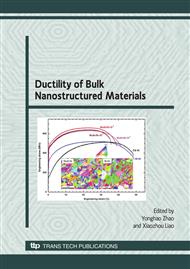p.615
p.637
p.647
p.657
p.665
p.675
p.685
p.697
p.707
A Simulation of the Abnormal Grain Growth in a Nano-Structural AZ31 Mg Alloy by Phase Field Model
Abstract:
Abnormal grain growth was simulated by phase field model in order to find ways of producing scattered a few enormous grains in a nano-structural single phase AZ31 alloy to improve its ductility. It is shown that the abnormal grain growth is controlled by the three keys factors of interface energy, strain restored energy and interface mobility. Therefore, the microstructure with scattered a few enormous grains in the nano-structural matrix can be achieved after an annealing treatment if there is a small group of specially orientated nano-size grains in the original nao-structure with local low grain boundary energy or local high strain energy or local high interface mobility. The morphology of abnormal grains is also examined as function of annealing time to optimize the microstructure.
Info:
Periodical:
Pages:
697-705
Citation:
Online since:
November 2009
Price:
Сopyright:
© 2010 Trans Tech Publications Ltd. All Rights Reserved
Share:
Citation:


